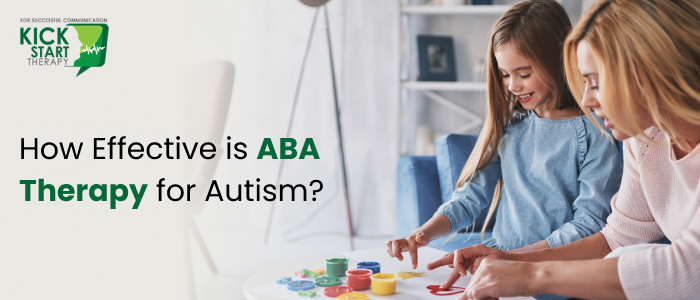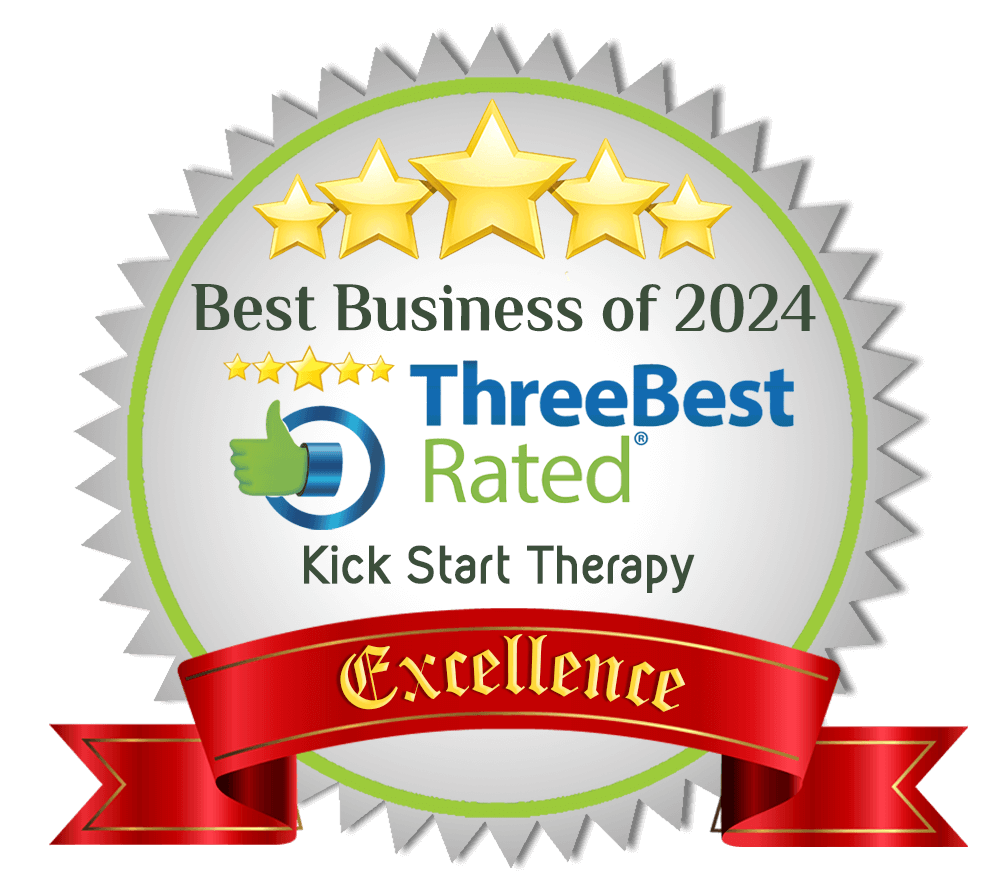
We all want the best for our children and make every effort to keep them happy. But as a parent, it’s heartbreaking to watch our children struggling to keep up. Autistic children often find it really hard to live an active social life. Although there is no medical treatment for the disorder yet, there are some rays of hope in the form of Applied Behavior Analysis (ABA) Therapy.
But how effective is ABA therapy for Autism? There is growing scientific evidence that proves early ABA intervention can improve various developmental delays, including intellectual disabilities, Asperger’s syndrome, and behavioral disorders like ADHD.
To evaluate the effectiveness of ABA, let’s look at the clinical statistics. As per the latest Surgeon General’s autism treatment report, ABA therapy accounts for 45% of therapies that yield impressive outcomes for individuals with ASD.
If you’re still unsure about whether your autistic child needs ABA therapy, this detailed guide will help you a lot. We will try to answer every possible question you have regarding this therapy.
Autism Spectrum Disorder (ASD) is a condition, often referred to as a neuro-developmental disorder, that affects an individual’s communication and social abilities. The condition is related to brain development that impacts how individuals understand and socialize with others.
Autism is not a disease or illness but a developmental disorder that needs intensive care and support. According to the CDC, 1 in 36 American children have autism. However, there’s a slight decline in numbers, which were 1 in 44 previously.
The symptoms of ASD generally appear in the first two years, which mainly include limited eye contact, no response to names, delayed speech, lack of response, no pointing, repetitive movements, overreaction, and unusual fascination.
Autistic individuals may find it hard to:
Applied Behavior Analysis (ABA) is an evidence-based therapy treatment that helps autistic individuals increase their social abilities, such as communicating, task completion, and learning new skills.
Although ABA is most commonly used for a wide range of developmental and behavioral conditions, it is often considered synonymous with specialized autism therapy. The therapy is primarily provided by Board-certified Behavior Analysts (BCBAs) and Registered Behavior Technicians (RBTs).
Practitioners use ABA techniques and methods to help individuals improve specific behaviors, such as social skills, communication, reading, and academics, and adaptive learning skills, like fine motor dexterity, hygiene, grooming, domestic capabilities, punctuality, and job competence.
The most effective research-backed best practices include ABA methodologies such as differential reinforcement, extinction, and task analysis.
ABA therapy has proven its effectiveness for individuals with ASD. The earlier you start, the chances of improvement increase likewise.
Here are some benefits of ABA Therapy for ASD:
ABA therapists work with autistic individuals to develop essential skills required to communicate, interact, and socialize with the world. This includes enhancing social interaction, communication, daily living, academic, and play skills.
ABA therapy has proved its worth in terms of improving challenging behaviors that may make it difficult to live an active social life. The therapy can help with aggression, anxiety, self-injurious and repetitive behaviors. Practitioners identify the triggers that lead to these behaviors and develop strategies to improve them with more appropriate responses.
The most common struggle for an autistic individual is to interact socially with others. However, applied behavior analysis can help them learn how to start conversations, understand social cues, and build better relationships.
ABA therapy can help individuals learn essential communication skills, whether they are about verbal or non-verbal. The most common techniques in this therapy include picture exchange communication systems (PECS), verbal behavior therapy, or augmentative and alternative communication (AAC) devices.
It is obvious individuals with Autism Spectrum Disorder (ASD) struggle to lead a normal life as others. They even find it challenging to do daily activities. However, ABA therapy can help them learn essential daily living skills, such as grooming, dressing, toileting, cleaning, and even cooking. It helps self-sufficiency and independence.
ABA and speech therapists can work with educators to create personalized education plans (PEPs) and use strategies to support academic excellence for students with ASD.
Applied Behavior Analysis (ABA) therapy is one of the effective techniques for helping people with autism spectrum disorder (ASD). Studies show the success rate of ABA therapy, with over 89% improvement in important areas like IQ, communication, and language skills.
Many studies point out that ABA therapy helps improve daily living skills and social behaviors in children with ASD. For example, a study from 2012 found that children who started ABA therapy early and had intensive treatment saw significant improvements in thinking, school, and social skills compared to children who didn't get early therapy.
Early intervention makes it more effective for children with autism. Children who start therapy before age three show significant improvements. One study showed that children who began therapy at 12 months had fewer signs of autism in social communication and repetitive behaviors compared to older children who didn't get early therapy.
There are different ways to perform ABA therapy, and therapists can use just one method or multiple strategies in combination.
DTT is a structured technique of ABA where the therapist works one-on-one with the child. The therapist gives the child instructions (like "point to the red triangle"). If the child answers correctly, they get a reward, such as a token or a high-five. If the child answers incorrectly, the therapist tries again.
EIBI is an intensive ABA method, usually done for 20 to 40 hours each week with children under five. Although more research is needed, EIBI may help children with autism develop everyday skills, language abilities, and academic skills.
PRT is performed in a natural setting and is led by the child. For example, if the goal is for the child to interact with others, a therapist might set up a bubble activity for a group of kids. The therapist will not force the child to join in, but the child might want to play if they enjoy bubbles.
ESDM is a combination of free play and structured activities. It's usually for babies and toddlers with autism, between five and twelve months old. This therapy focuses on building social, emotional, and language skills and cognitive abilities. Unlike other methods, ESDM may have multiple goals for each activity.
VBI helps children with disabilities develop language skills. Typically, children without disabilities first learn to name things, which behavior experts call “tacts.” For example, a toddler might point at a toy and say, “Car.”
NET happens in the child's usual surroundings and follows their everyday routine. This helps the therapist understand what skills the child needs daily and allows the child to learn new skills in their regular environment.
People have mixed opinions about whether ABA therapy is effective or harmful, and the answer depends on personal views, experiences, and needs. If we believe statistics, ABA therapy seems effective in helping autistic individuals improve their skills. It can teach them how to communicate better and reduce harmful behaviors like self-injury.
However, some believe ABA therapy can be harmful, especially if it's done too strictly or aims to stop harmless autistic behaviors. Some autistic individuals say ABA makes it seem like behaviors like stimming (repetitive movements) and avoiding eye contact are bad. Trying to stop these behaviors might make autistic people hide their autism, which can be very stressful and lead to serious mental health issues.
On the other hand, some healthcare professionals believe that when ABA is done correctly, it can help autistic people with more complex needs become more independent.
There are many ways ABA therapy can be personalized to each child's unique needs. This way, practitioners can make sure the services fit your child's specific needs, abilities, and goals. ABA doesn't believe in a one-size-fits-all approach. Instead, it focuses on creating personalized goals and treatment plans that work best for each child.
The first step in ABA therapy starts with a detailed evaluation to understand the child's strengths, behaviors, and challenges they are facing. This includes observing the child, talking with parents or caregivers, and using standardized tools. The findings help in making customized treatment plans.
ABA goals are set by behavior therapists based on the child's unique stage of development, needs, and family priorities. These goals usually aim to improve social skills, communication, and daily living skills and reduce challenging behaviors.
ABA therapy uses continuous data collection to track the child's progress. Therapists use this data to adjust treatments, ensuring the child is reaching milestones or to change strategies if needed.
ABA therapy is often carried out one-on-one, which helps the therapist to focus solely on the child's needs. Sometimes, group settings are also used to teach social skills when suitable.
Parents and caregivers are part of the process, learning ways to help the child outside of therapy. This makes ABA more effective in different settings. It also allows the therapist to adjust interventions based on what works at home.
As the child grows and changes, so does the ABA program. Goals are updated to uphold the usefulness of the therapy. This personalized approach is helpful in ensuring each child gets ABA therapy tailored to their own growth and development.
ABA therapy can be expensive, especially considering the time commitment involved. The average cost per session in Canada typically ranges from $50 to $200. Since ABA therapy often requires multiple sessions each week, the costs can quickly add up. However, there are financial assistance programs like the Ontario Autism Program (OAP) available to help alleviate the burden.
It is a government-funded program in which families receive financial support to access essential services and therapies for their children with Autism. The wait time for a diagnosis can vary significantly. On average, families can expect to wait anywhere from 6 months to 3 years for a diagnosis. This lengthy wait time is due to the high demand for diagnostic services and the limited number of qualified professionals available to perform the assessments.
Once a diagnosis is obtained, families may still face additional wait times of 6 months to 4 years to access services and support through the OAP. This can be a source of stress for families, as early intervention is often crucial for children with autism
So, while waiting on the OAP waitlist, you can avail therapy services at subsidized rates at Kick Start Therapy, as it is one of the authorized service providers under the OAP in partnership with PCHS. They offer personalized interventions tailored to each child's unique needs.
While ABA therapy is a common choice for autism treatment, several other approaches can also be effective:
Despite challenges and criticism, Applied Behavior Analysis (ABA) therapy has proved its effectiveness over time. As Autism isn’t a disease or illness, there are higher chances of improvement in the condition over time. Although there’s no other medical treatment available for ASD, behavior therapies are the only hope. If they are performed by professionals and registered practitioners, their chances of effectiveness increase significantly. So, if you’re looking for a registered ABA therapy center in Brampton, Mississauga, it's best to get in touch with Kick Start Therapy.
We tried to answer every possible question about ABA therapy for autism. If you still have questions related to ABA therapy or OAP, you can read our insightful blogs.
ABA (Applied Behavior Analysis) therapy aims to improve social, communication, and learning skills through reinforcement strategies. It's tailored to each individual's needs, helping them to acquire useful skills and reduce behaviors that may interfere with daily functioning.
A common example of ABA therapy is using a reward system to encourage a child to make eye contact. If the child makes eye contact, they receive positive reinforcement like a favorite snack or praise, gradually increasing the behavior over time.
Disadvantages include its high cost, intensive time commitment, and sometimes, it may be perceived as overly rigid or repetitive. Additionally, it might not be as effective for every individual, and there is ongoing debate about its long-term efficacy and ethical considerations.
ABA therapy is most effective when started early, typically between the ages of 2 and 5. However, it can be beneficial at any age, as the principles can be adapted to suit various developmental stages and individual needs.






